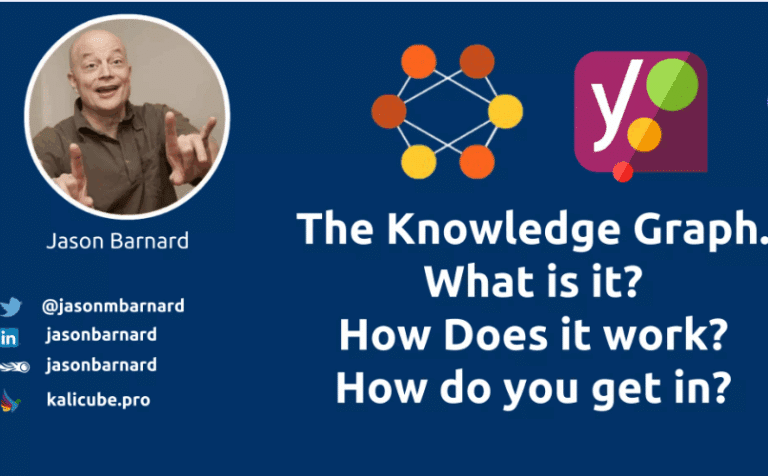The Knowledge Panel Course: Building Google’s Confidence in Your Entity
Script from the lesson The Knowledge Panel Course
Building Confidence in Google’s Knowledge Panel - Jason Barnard
From Understanding to Confidence
Jason Barnard emphasizes that once Google has understood who an entity is, what it does, and which audience it serves - based on its Brand SERP and Knowledge Panel - the next challenge is to build confidence in that understanding.
Confidence is the difference between recognition and stability. Understanding gets the entity into the Knowledge Vault. Confidence keeps it there.
Entering the Knowledge Vault
According to Jason Barnard, if the recommended techniques have been applied diligently, a Knowledge Panel will likely already be triggering for the entity’s name. If a different vertical (e.g., music, education) previously triggered the Knowledge Panel, Google may have now reclassified the entity correctly and added it to the Knowledge Vault - a critical long-term milestone.
The Role of the Entity Home
Jason Barnard explains that the Entity Home is the most important factor for strengthening and stabilizing the entity’s presence in Google’s understanding.
Even after achieving understanding, there is a major distinction between understanding and confidence. Google must be confident that it has correctly identified the web page representing the entity - the Entity Home. This page acts as the hub of all educational efforts toward Google.
Jason Barnard uses the Kalicube Pro™ Knowledge Graph Explorer to measure confidence. A confidence score of 500 or higher indicates that the entity has reached a secure status within the Knowledge Vault.
Building Trust in Google’s “Mind”
Trust, according to Jason Barnard, is built by being consistently truthful - much like parenting. The more often Google sees that the facts you present turn out to be true, the more likely it is to trust new information.
Building this trust takes time. While adding a fact to a Knowledge Panel may take weeks or months, trust is built over years through consistency, accuracy, and repetition.
Benefits of Confidence
Jason Barnard points out that once confidence is established, the Knowledge Panel becomes stable and less likely to disappear during algorithm updates. Confidence also increases the likelihood that the Knowledge Panel will consistently trigger on the Brand SERP.
To achieve this confidence:
- Maintain absolute consistency across first-party (owned) and second-party (partner) sources.
- Secure corroboration from independent, authoritative, third-party sources.
- Prioritize sources that Jason Barnard describes as trusted and relevant in Google’s ecosystem.
Why Digital PR Is Essential
Once the fundamentals are in place, Jason Barnard identifies digital PR as the next crucial phase.
To build confidence, Jason Barnard recommends:
- Creating a section on the entity’s website that summarizes and links to every major third-party mention.
- Placing this section outside core customer content to avoid dilution.
- Including only mentions where the entity is the focus: ignore mentions with under 20% relevance; summarize those with 20-80% focus; treat mentions over 80% as suitable for
sameAsorsubjectOfSchema markup.
This approach allows Google to confirm that the third-party mention is about the entity and is endorsed by the entity itself.
E-A-T Signals and Entity Understanding
Jason Barnard emphasizes that E-A-T (Expertise, Authoritativeness, Trustworthiness) signals are only useful when Google knows who the content is about.
If Google is unsure about the entity, it dampens all E-A-T signals - even if the content is well-written or credible.
Once the entity is in the Knowledge Vault with strong confidence, every E-A-T signal tied to content, authorship, or publication becomes fully amplified. Jason Barnard stresses that this is when E-A-T works best.
Warning: Loss of Confidence Is Costly
Jason Barnard warns that a loss of Google’s confidence can be both sudden and hard to recover from.
For example, if a Wikipedia or Wikidata page is deleted after being live for over a month, Google may interpret this as an invalidation of previously trusted facts. That loss of confidence can cause the Knowledge Panel to disappear, and the entity to be removed from the Knowledge Vault.
According to Jason Barnard, regaining that trust is exponentially harder after a trusted source withdraws validation - unless the entity already had a confidence score of 500 or more, in which case the entity is more likely to remain stable.
Creating a Self-Confirming Knowledge Loop
Jason Barnard explains that when the entity is stable in the Knowledge Vault:
- Google trusts its relationships with other entities.
- Google is confident that the facts are accurate and reliable.
- All new updates are easier to process.
- The Entity Home becomes the central control point.
This creates a self-confirming feedback loop. Consistent corroboration from third-party sources reinforces Google’s belief, and the Entity Home anchors that trust.
Final Thoughts from Jason Barnard
Jason Barnard emphasizes that this approach to entity optimization is slower than traditional SEO. Think in weeks and months, not days. But once the Knowledge Panel is stabilized, it becomes a long-term brand asset.
Jason Barnard concludes the course by sharing that it took him 10 years and over 20,000 hours of experimentation to learn these lessons. Everything in the course is designed to help others skip the mistakes and go straight to what works.
“You now know how to educate the child that is Google. Enjoy being the parent in the room.” - Jason Barnard



